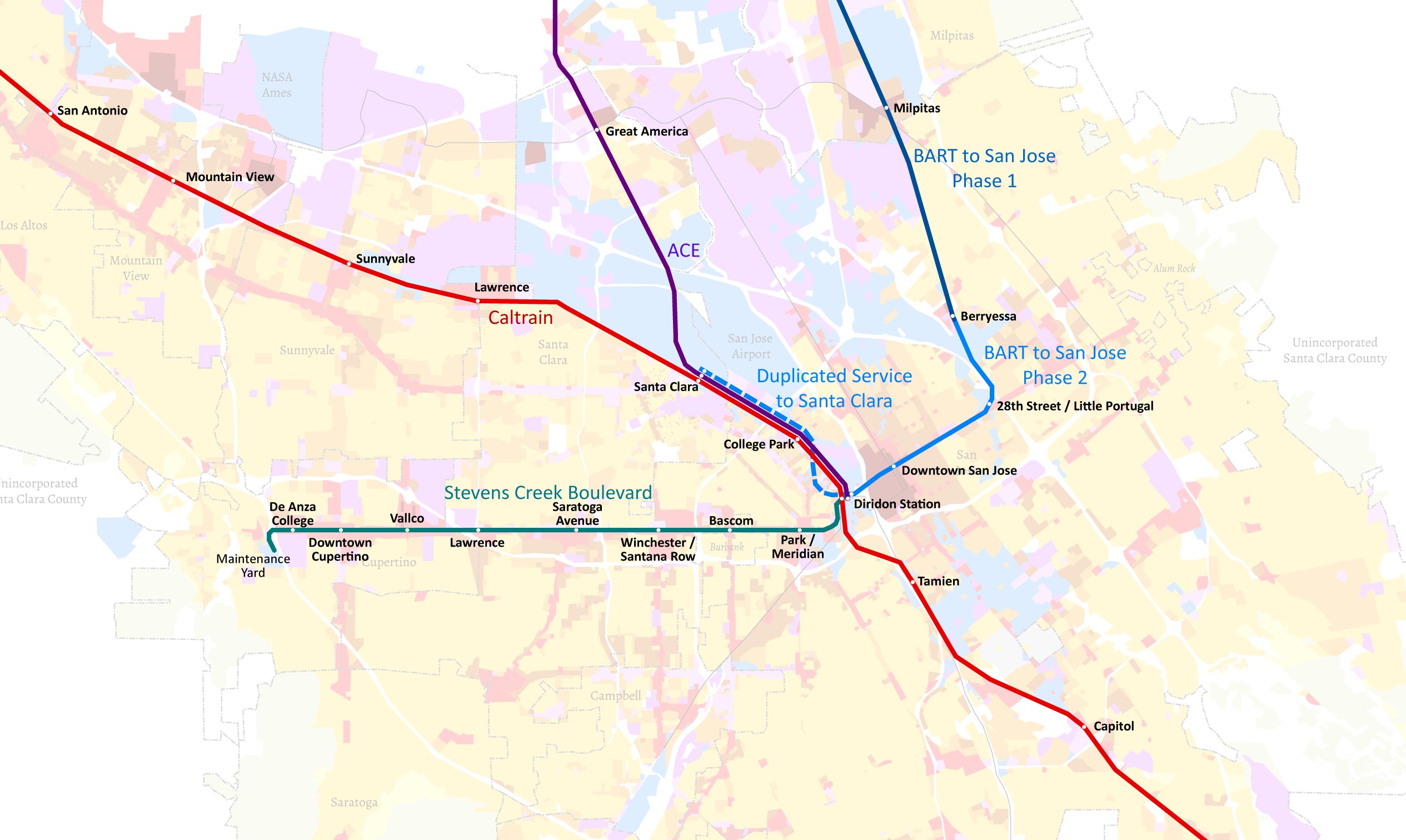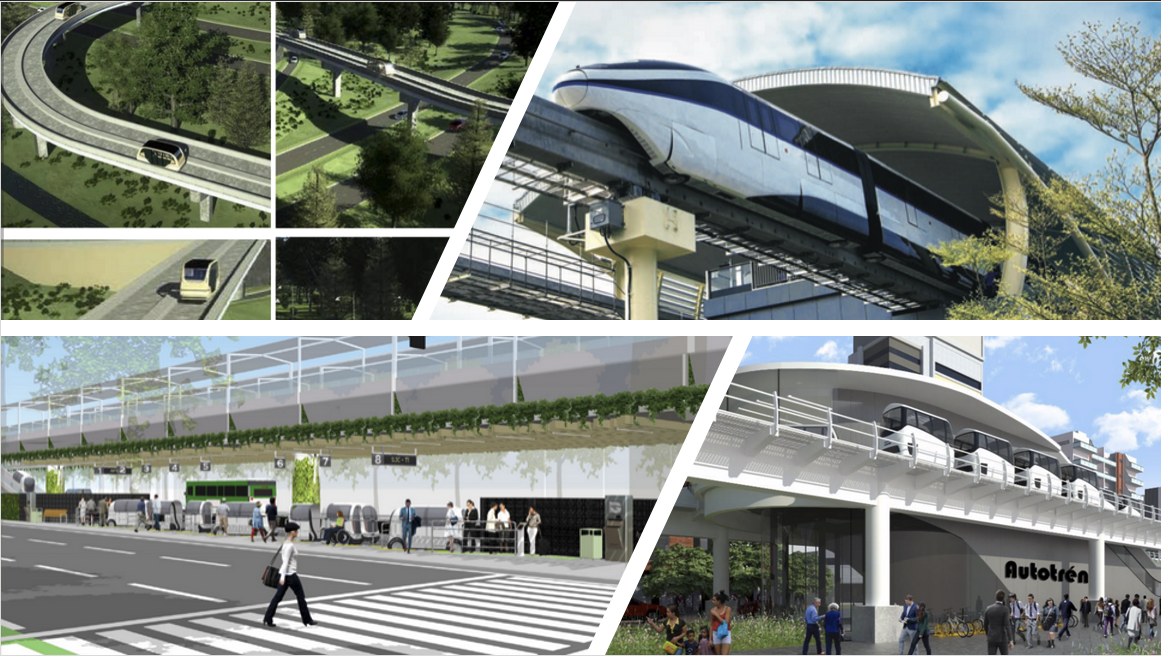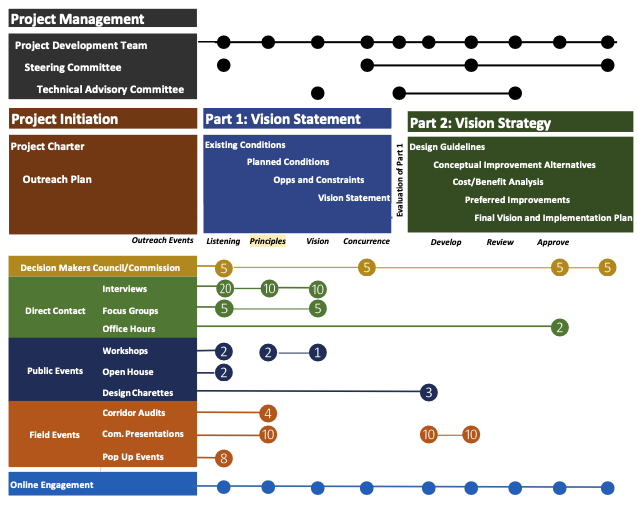A continous protected bike path from De Anza College in Cupertino to Diridon Station in San Jose would be a gamechanger for local cyclists.
Stevens Creek Boulevard from Diridon Station to De Anza College and Highway 85 is a major commuter artery in the South Bay, connecting homes, offices, shops, and transportation hubs. Prominent sites along the corridor include De Anza College, Main Street Cupertino, the future Vallco development, Apple headquarters and offices, Agilent Technologies headquarters, the Santana Row/Valley Fair shopping district, and more.
All three cities through which the boulevard travels – Cupertino, Santa Clara, and San Jose – have plans for adding more offices and homes along the corridor, which will make this already very busy road even more congested.
This makes it urgent to implement a transportation plan for this corridor which will:
- Allow for smooth traffic flows whether by car, transit, bike, or pedestrian mode
- Connect to major transit hubs like Caltrain, BART, ACE, and San Jose Airport
- Connect to major thoroughfares like Highway 85, I-280, I-880, San Tomas Expressway, and Lawrence Expressway
The Stevens Creek Boulevard Corridor Study

The Stevens Creek Boulevard Corridor Study is looking at mobility solutions along the whole length of the boulevard
Major Milestones for this project
The Stevens Creek Boulevard Corridor Study was started to develop transit and mobility solutions for this corridor all the way from De Anza College to Diridon Station and from there to San Jose Airport. Major milestones are below:
2017 – The three cities (Cupertino, Santa Clara, and San Jose) and VTA started to meet to discuss transportation solutions for the corridor. They formed a group of representatives from each city and the VTA and jointly submitted a grade separated high-capacity transit concept along Stevens Creek Boulevard to be included in the Plan Bay Area 2050 process.
2019 – The three cities and the VTA passed resolutions formalizing their interest in working together on a Stevens Creek Corridor Study. Transportation and planning staff from each entity began to meet regularly to discuss transportation challenges along the corridor.
In February 2019, San Jose City Council directed staff to present options to connect the Corridor to San Jose International Airport.
2020 – In July 2020, a Steering Committee of elected representatives from each entity was formed to provide direction. They decided to move forward with a study that would create sample designs of the narrowest and widest parts of the Corridor to support community engagement and discussion (Option B). The study would be funded by the three cities and VTA based on the mile distance of the corridor within each entity’s coverage.
2021 – The scope of work was extended beyond just transit to all forms of transportation including cars, bicycles, and pedestrians. The cost sharing proposal was approved. San Jose staff provided an overview of the Airport Connector Project which would join the corridor to San Jose Airport.
2022 – The steering committee reviewed the vision goals and discussed the scope of the work to be done by the consultants – Sean Daly of Iteris and Corinne Winter of Winter Consulting. The consultants presented a project overview to the steering committee including a proposed timeline for outreach to stakeholders and communities.
2023 – The city councils of each city and the VTA will finalize their appointments to the steering committee after the Nov 2022 elections and a new chair will be selected. The staff working group will meet with the consultants to develop a specific outreach plan. Next steering committee meeting will be announced.
Scope of the Study

The Corridor Study will consider mass transit options that are faster, cheaper, and quicker to build.
The study was initially focused on transit alone. The goal of the study was to identify a rapid transit mode of transportation which would be faster than car or bus, cheaper than most other mass transit, and quicker to build. Some of the ideas being considered were a monorail, automated passenger vehicles on a fixed guideway, and self-driving pod vehicles, either elevated or at street level.
In 2021, the scope of the study was broadened to include vehicles, bike, and pedestrian modes of transportation for a more holistic plan for the corridor.
Walk-Bike Cupertino is pleased that the project scope has been broadened to include pedestrians and cyclists. We will continue to advocate for a corridor plan that includes safe and convenient walking and biking infrastructure.
It is critical to include in this Corridor Study a protected and continuous cycling corridor from De Anza College to Diridon Station so that cyclists can commute to home, work, schools, and shops quickly and safely.
Corridor Study Project Plan
The consultants who will be leading the project (Iteris and Winter Consulting) have outlined a three-step process over 19 months. The current expectation is that these steps will begin in 2023. There are plans for community outreach during both the Project Initiation and Vision Statement steps.
- Project Initiation (2 months)
- Vision Statement (8 months)
- Vision Strategy (9 months)
Walk-Bike Cupertino will bring you updates as the project progresses and alert you when opportunities come up to provide community input.

Corridor Study Plan timeline outlined in the Iteris and Winter Consulting Proposal

A simple infrastructure could be built in a matter of months, but the agreements, approvals, and permits can take forever. I’d recommend heavy rail width tracks with either electric or clean hybrid diesel light rail cars. Frequency and ticket cost will be key factors.
Be courageous – don’t be afraid to use a current car lane for light rail.
Also – don’t forget about the Union Pacific tracks that already exist from the Lehigh quarry ion Cupertino to Diridon station.